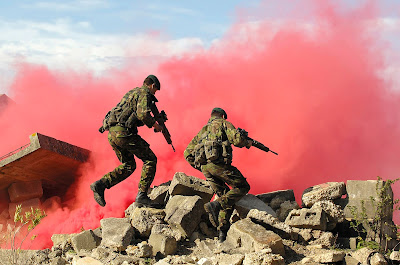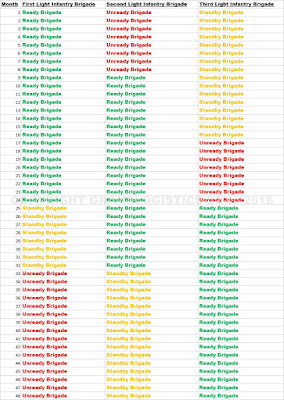The Light Infantry Division shall follow the same flexible readiness cycle as the Medium Infantry Division,the Heavy Cavalry Division and the divisions of Corps and Army troops (but not the Royal Marines Division which shall follow the Royal Navy readiness cycle) which shall consist of three readiness states and which shall allow one third of the division to be deployed,or ready to be deployed,all of the time or all of the division one third of the time.
Troops in a "Ready" state shall be available for immediate deployment,or deployed,for a period not exceeding sixteen months.
Light Infantry troops in a "Standby" state,shall be available for non routine deployments of up to eight months at ninety days notice,consisting of thirty days notice to muster and thirty days training for the fencibles who relieve the Light Infantry troops from their "Standby Tasks" (ceremonial duties,garrison duties,training support,domestic defence,aid to civil authorities and contingency reserve) followed by thirty days pre deployment training for the relieved Light Infantry troops,with the exception of the contingency reserve which shall be ready for immediate deployment.
Troops in an "Unready" state shall not be available for deployment for sixteen months in a forty eight month period as they shall be resting,re-equipping,retraining or transiting (for the sake of clarity unready periods have been shown as a single block in the following examples,in practice there shall be a short unready period of transiting,decompressing and training between ready and standby periods).
The readiness cycle shall normally start with an unready period during which troops shall be prepared for combat followed by a ready period and ending with a standby period allowing time to decompress under military discipline post deployment but the readiness cycle shall be flexible and shall be adjusted as required within the limits of the Conditions Of Service which shall mandate a maximum of sixteen months of routine operational deployments (and up to eight months of non routine operational deployments) in a forty eight month period.
Photo: Grand Logistics
The Light Infantry Division may keep one of it's three Brigades ready for immediate deployment (or deployed) at all times if the three brigades are one hundred and twenty degrees out of phase in the readiness cycle,as shown above.
This ready brigade may be immediately reinforced by the contingency reserve of the standby brigade or,with ninety days notice,by the full standby brigade for a period of up to eight months.
Photo: Grand Logistics
With a maximum of sixteen months notice,two Light Infantry Brigades may be brought in to the ready state at the same time for a period of sixteen months by means of putting one brigade in to it's standby state before,rather than after it goes in to it's ready state,as demonstrated above by the Second Light Infantry Brigade going in to the standby state in month seventeen so it can go in to the ready state in month thirty three,in phase with the Third Light Infantry Brigade,before reverting to being one hundred and twenty degrees out of phase with the Third Light Infantry Brigade in month forty nine.
Photo: Grand Logistics
For contingencies such as the "Iraq Surge" an irregular readiness cycle shall allow a more rapid increase to the number of brigades in the ready state at the expense of having each brigade ready for up to twenty four months out of forty eight,in the example shown above the Second Light Infantry Brigade shall enter the ready state eight months early in month nine,the fencibles shall be given notice to muster before month fifteen,they shall then take over the First Light Infantry Brigade's standby tasks from month seventeen until month twenty four,allowing the First Light Infantry Brigade to remain in the ready state for an extra eight months when it shall be relieved by the Third Light Infantry Brigade which shall enter the ready state eight months early in month twenty five,two brigades shall then be in the ready state from months nine to thirty two.
Photo: Grand Logistics
If there is sufficient advanced notice of a major operation all three brigades may be brought in to phase for a thirty two month period,allowing them to train and deploy as a full division,all three Light Infantry Brigades are one hundred and twenty degrees out of phase with each other in the first and last sixteen months of the ninety six month period shown above but all are in phase between months thirty three and sixty four,the First Light Infantry Brigade stays in it's normal readiness cycle throughout,the Second Light Infantry Brigade is advanced by one hundred and twenty degrees between the thirty third and eightieth months while the Third Light Infantry Brigade is advanced by two hundred and forty degrees between the seventeenth and sixty-fourth month.
Photo: Grand Logistics
The three close combat divisions,and proportionate elements of the corps and army troops, shall follow the same readiness cycle as the Light Infantry Division,as shown above,a ready brigade from each of the light,medium and heavy divisions would normally be be formed in to a mixed field division to ensure that a range of capabilities is available at all times to deal with any contingency which may arise.
If necessary,the Light Infantry Division,Medium Infantry Division and Heavy Cavalry Division may rotate through the cycle as homogeneous divisions as shown above.
Photo: Cpl. Paul Morrison R.L.C. Crown Copyright
In this manner,the Light Infantry Division may deploy all of it's brigades,a corps may deploy all of it's divisions and an army may be deployed with a full combat corps (consisting of a Light Infantry Division,a Medium Infantry Division,a Heavy Cavalry Division,a Headquarters Division and a Train Division) and a composite corps of army troops,including a Flying Division.
Photo: Cpl. Robert Thaler U.S. Army
Such a force shall be capable of dealing with any opponent the British Army has faced since the Second World War,unlike the single poorly equipped division which British Generals currently plan to deploy with the same force size and budget.











No comments:
Post a Comment